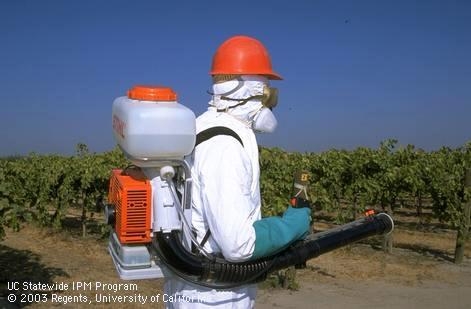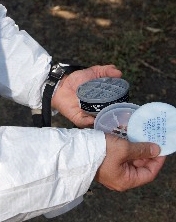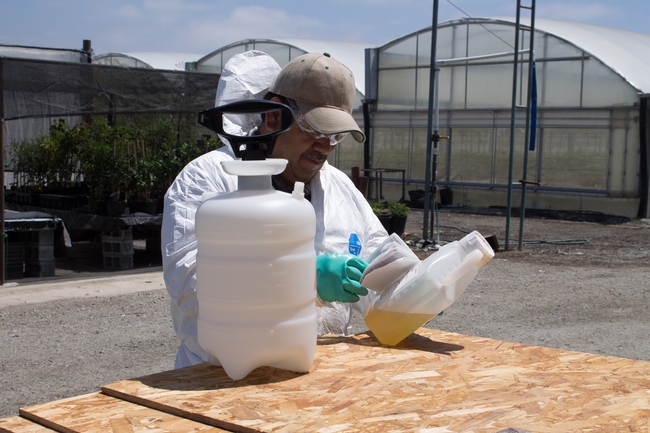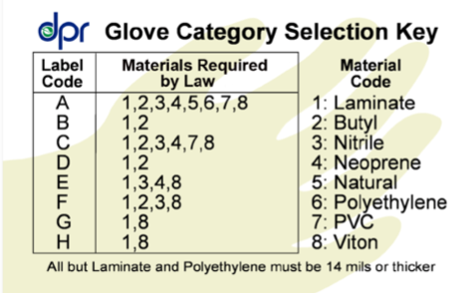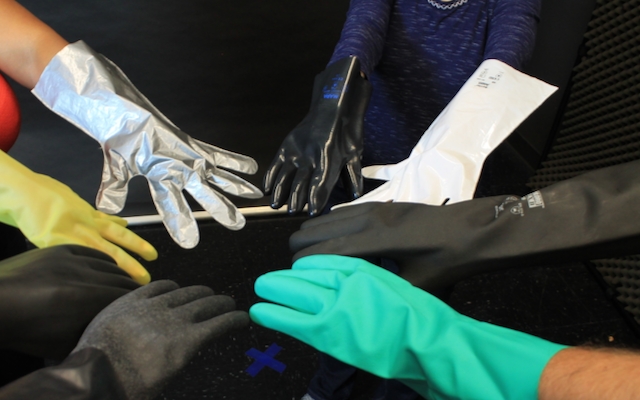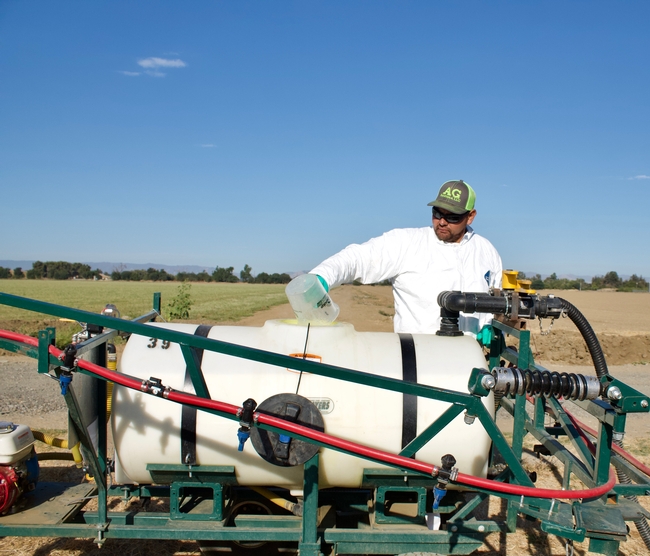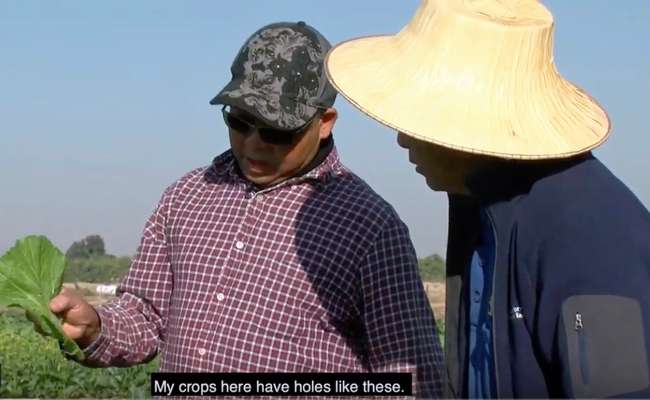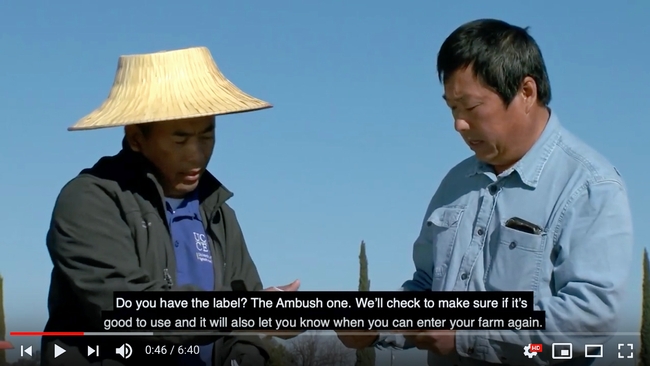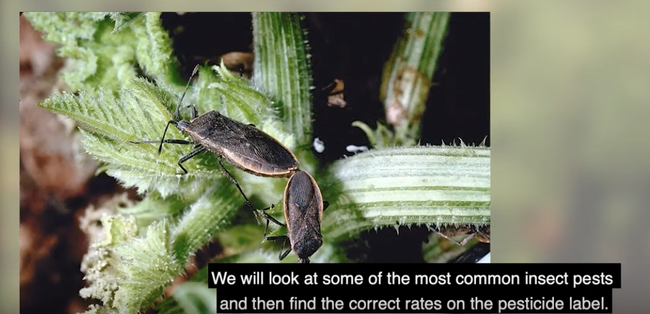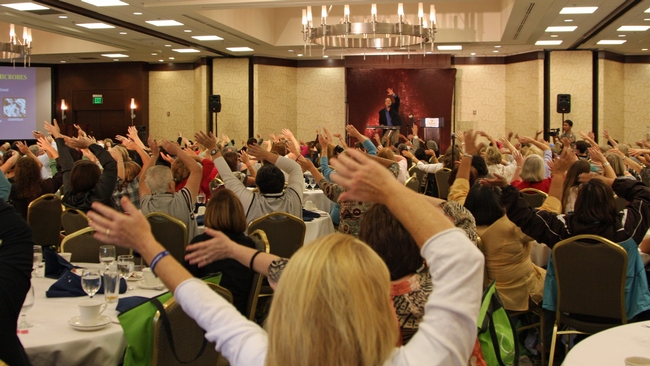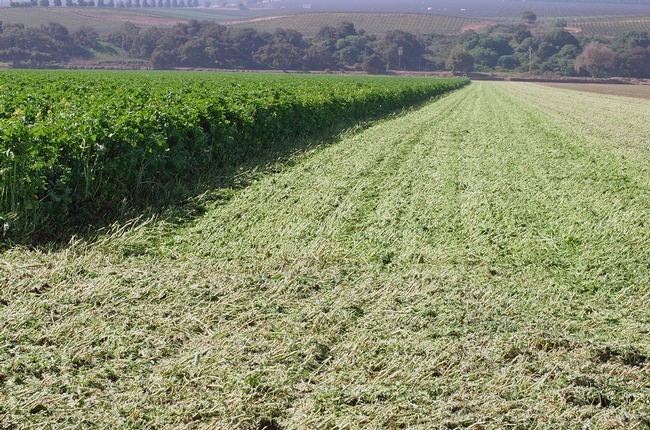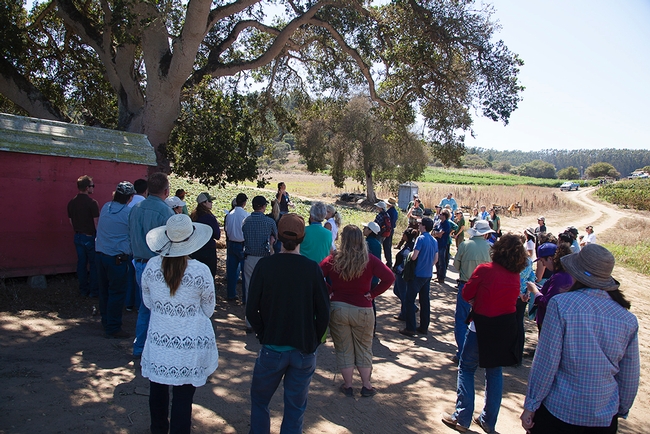Posts Tagged: Safety
PPE in short supply for farm work during the COVID-19 crisis
Gloves, N95 respirators, coveralls and other gear that workers wear to protect themselves from COVID-19, pesticides, dust and other health hazards are in short supply as priority is given to health care workers during the pandemic.
To reduce the spread of COVID-19, workers may wear homemade face coverings, but for applying pesticides, they must wear respirators specified on the pesticide product label, said Whitney Brim-DeForest, UC Cooperative Extension rice advisor.
Pesticide applicators may use gear that is more protective than required by the product label and regulations.
“Although this could change in the days ahead, half-mask and full-mask respirators are more available than disposable N95 respirators for now,” said Lisa Blecker, coordinator for the UC Pesticide Safety Education Program.
Before the pandemic, 10% of N95 respirators from 3M went to health care, but that number is now 90%, the company said in a letter to distributors. This has led to significant backorders of PPE supplies for distributors.
Carl Atwell, president of Gempler's, an online distributor of worker supplies, said that before the crisis, normal lead times for PPE was up to 10 days. He estimated disposable respirators will become available in the fall and other PPE supplies in August.
In the meantime, there is alternative PPE that agricultural professionals can use during the shortage.
Atwell suggests looking for lesser known brands of PPE as opposed to the first tier of choice: “It's sort of like searching for Purell hand sanitizer. Purell brand might be out of stock, but can you find a different disinfectant?”
On Gempler's website, the more recognizable Tyvek coverall from Dupont is sold out, however disposable protective clothing is available from other brands. Reusable chemical-resistant clothing is also available as opposed to their disposable counterparts. Supplies in high demand are reusable and disposable nitrile gloves, protective clothing, disposable respirators and certain protective eyewear, such as goggles and face shields.
For workers who will be applying pesticides, Blecker and Brim-DeForest offered some guidelines on how to meet PPE requirements as the shortage continues.
General PPE requirements: “Remember, the label is the law,” said Brim-DeForest. “PPE requirements for agriculture are not being loosened.” The UCCE advisor recommends purchasing only what you need for the season and choosing reusable PPE whenever possible. Growers who have excess supplies of PPE can coordinate with their county agricultural commissioner or UCCE advisor to help other producers in their area.
Respirators: If you can't find the respirator required on the label, Blecker said, “Use an alternative, more-protective respirator. For example, if an N95 is required, you can use a half-mask with N95 particulate filters; these can be stand-alone filters or ones that attach to an organic vapor cartridge. You could also use a different pesticide that doesn't require a respirator. Consult with your PCA (pest control adviser) for options.”
Gloves: Chemical-resistant gloves, usually 14 mil or more in thickness are required for most California pesticide applications and should be worn by mixers, handlers and applicators. If nitrile gloves are not available, viton and laminate gloves are universal chemical-resistant materials for most pesticide labels. If the glove material is specified on the label, that instruction must be followed.
“Disposable gloves less than 14 mil can be worn, but not for more than 15 minutes at a time,” Blecker said. “Farmers should also note that thinner gloves cannot be layered on top of one another.”
Coveralls: Coveralls should be worn when required by the pesticide label or when the signal word is “WARNING” or “DANGER,” or when applying by backpack or airblast. “Coveralls can be made out of high-density polyethylene fibers (Tyvek and other brands), which are disposable, or cotton, which are reusable,” Brim-DeForest said. “If reusable coveralls are worn, the employer must ensure employees are provided clean coveralls.”
Goggles/face shields: Face shields are required for mixing and loading pesticides only if it's stated on the label. “If a face shield is unavailable, a full-face respirator can be used,” Blecker said. “Goggles or protective eyewear should always be worn in California when handling pesticides, regardless of what the label says. The face shield, goggles or safety glasses must provide front, side and brow protection and meet the American National Standards Institute Z87.1 standard for impact resistance.
The UC Integrated Pest Management Program also covers these topics in their pesticide safety webinar series at http://ipm.ucanr.edu/IPMPROJECT/workshops.html.
For more information about PPE, contact your county agricultural commissioner or see the California Department of Pesticide Regulation's posters at https://www.cdpr.ca.gov/docs/whs/pdf/gloves_for_pesticide_handling.pdf and https://www.cdpr.ca.gov/docs/whs/pdf/n95_alternatives_for_pesticide_handling.pdf.
Hmong-language pesticide safety videos now online
DPR, Fresno State and UCCE create pesticide safety videos with Hmong farmers
A series of videos describing California pesticide rules and safety in Hmong is now available to view for free online. The videos were produced by California State University, Fresno and UC Cooperative Extension in Fresno County with funding from the California Department of Pesticide Regulation.
The nine-part video series – Complying with Pesticide Laws and Regulations in California – is part of DPR's mission to reach California's farming communities. The videos cover a number of topics including using personal protective equipment, understanding pesticide product labels and application permit requirements.
The innovative educational tool blends peer-to-peer communication with traditional extension methods to include the knowledge and experience of both farmers and extension experts. Hmong farmers featured in the video helped develop scenes in which they educate other farmers, purchase and use personal protective equipment, and interact with extension staff.
“We worked with Hmong farmers who are following pesticide regulations themselves, and are now giving back to educate their peers,” said Ruth Dahlquist-Willard, UC Cooperative Extension small farm advisor, who collaborated on the video production. “Their voices and expertise helped make the scenarios more realistic and accessible to other farmers in the Southeast Asian community.”
Michael Yang, longtime UC Cooperative Extension small farms and specialty crops agricultural assistant, stars in the videos, interacting with farmers based on his extensive experience and trusted relationships in the Hmong farming community, and narrating the educational content in Hmong.
“We hope the videos broaden the reach of our local extension programming to help more farmers understand pesticide regulations and avoid fines, as well as improve their safe handling, selection and use,” said Yang.
Dahlquist-Willard and Yang plan to show the videos at UC Cooperative Extension meetings with Hmong farmers and distribute copies on flashdrives to county Agricultural Commissioner's offices in Fresno County and beyond. The videos are captioned in English.
“DPR works with all types of farmers on pesticide issues and it's critical that they use these tools safely – regardless of the language they speak,” explained DPR Director Val Dolcini. “This video project, the first of its kind to use Hmong speakers, will help foster safer use of pesticides.”
The videos can be viewed at http://bit.ly/fs-dpr-hmong-pesticide-video. The modules in the series cover:
- Introduction to California Pesticide Laws
- Checking for Crops Registered on the Label
- Pests and Application Rates on the Label
- Understanding Signal Words
- Following the Restricted Entry Interval (REI)
- Following the Pre-harvest Interval (PHI)
- Knowing Common Restrictions on the Label
- Using Personal Protective Equipment (PPE)
- Pesticide Permits and Reporting requirements
The project took 700 hours over 18 months to complete, including filming and post-production. Twelve Fresno State students were also involved in producing the videos with the Hmong farmers in Fresno County. Dahlquist-Willard and Yang provided the creative direction in partnership with the farmers involved, and Fresno State's MCJ Multimedia Production Service under Professor Candace Egan brought professional video production and editing skills to make a high-quality finished product. Fresno State student video editor Mali Lee, a fluent Hmong speaker, completed the final edits of the Hmong language material.
“This was one of the most rewarding projects I have ever worked on,” said project director Bill Erysian of Fresno State. “We brought together a unique group of agricultural specialists, students, farmers and video professionals to create a high impact, professional set of educational videos on pesticide compliance for our Hmong farmers here in California.”
DPR has comprehensive pesticide safety and outreach material available in Punjabi, Spanish and English at https://www.cdpr.ca.gov/docs/whs/worker_protection.htm.
UCCE specialist Carl Winter, the “Elvis of E. coli,” retires after 32 years
He has been called the “Elvis of E. coli” and the “Sinatra of Salmonella,” and now Carl Winter, a UC Cooperative Extension food toxicologist for 32 years, will rock and roll his way into retirement on July 1, 2019.
Based at UC Davis, Winter researches the detection of pesticides and naturally occurring toxins in foods, how to assess their risks and how to use science in the regulatory decision-making process.
His most recent work includes investigating the relationship between allowable levels and safety levels for pesticide residues on food crops. Author of numerous journal articles, books and book chapters, he has testified before the U.S. Congress on four occasions and has given nearly 1,000 scientific presentations and more than 1,000 media interviews over the course of his career.
The internationally respected food-safety expert is equally known for using humor and music to communicate important messages about food and agriculture.
“Dr. Winter has been a strong and reassuring voice for consumers about the safety of produce and a positive influence on fruit and vegetable consumption,” said Teresa Thorne, executive director of the Alliance for Food and Farming. “He has been an invaluable resource for media, consumers, his students and the produce industry because of his ability to make complex issues understandable. He has set such a high standard and his voice will be missed.”
Winter, who is an accomplished musician, also studies how to improve educational activities by incorporating music into food safety curricula. His humorous musical parodies about food safety aim to educate through entertainment. Accompanying himself on keyboard and guitar, Winter covers Will Smith's “Gettin' Jiggy Wit It,” as “Don't Get Sicky Wit It,” and The Beatles' “I Want to Hold Your Hand” becomes “You'd Better Wash Your Hands.”
The food safety musician has performed songs at nearly 300 scientific conferences and meetings in 37 states with his own lyrics, such as “Hey, Salmonella, did you think I'd lay down and die?” for Gloria Gaynor's “I Will Survive.” He has distributed 30,000 audio CDs and animated DVDs and his YouTube page has received more than 1 million views. Winter's food safety videos can also be seen at http://foodsafe.ucdavis.edu/html/video.html.
A Fellow of the Institute of Food Technologists, Winter has received numerous awards, including the 2012 Borlaug Council for Agricultural Science and Technology Communication Award; the Hod Ogden Medal from the U.S. Centers for Disease Control and Prevention /Association of State and Territorial Directors of Health Promotion and Public Health Education, for “his innovative and creative musical approach to educate the public about food safety”; the National Science Foundation International Food Safety Leadership Award for Education and Training; and the Institute of Food Technologists Bernard L. Oser Food Ingredient Safety Award.
Winter, who was vice chair of the UC Davis Department of Food Science and Technology for the past six years, also served as a member of UC Agriculture and Natural Resource's Program Council from 2015 through 2019.
In retirement, he plans to continue playing keyboard and guitar for the Northern California bands Petty Jack Flash, Keep on Truckin', and Elvis and the Experience, as well as travel throughout the world with his wife, Robin.
UCCE offers online training for protecting food safety and natural resources
On their farms, growers are active stewards of the land, protecting soil quality and water quality as well as supporting wildlife by preserving their habitat. At the same time, fresh produce growers must ensure that their crops are free from pathogens that can cause foodborne illnesses.
To help growers and food safety professionals achieve all of these important goals, UC Cooperative Extension has launched a free online course.
“Actions that farmers take to protect food safety may affect natural resources, and conservation practices may affect food safety,” said Mary Bianchi, UC Cooperative Extension advisor in San Luis Obispo and Santa Barbara counties, who oversaw design of the course.
The intent of the training is to demonstrate that communication between food safety professionals and growers can help to achieve a balance between food safety and sustainability.
“Our co-management course will help food safety professionals better evaluate the risk of conservation practices,” said Bianchi.
“For example, cover crops attract beneficial insects, help control soil erosion and improve soil quality, but they may attract wildlife,” she said. “In the course, we demonstrate frank conversations between food safety auditors and growers about strategies for minimizing the potential risks of crops being contaminated by animal feces. Growers can often provide existing examples, such as monitoring programs or temporary fencing that excludes wild and domestic animals from produce fields.”
The course also provides growers with tools to evaluate their strategies for managing food safety and sustainability.
“After the training, growers and auditors will be better prepared to engage in realistic and frank discussions of co-management strategies used in crop production,” Bianchi said.
The free online co-management course and related resources are online at http://cesanluisobispo.ucanr.edu/Co-management_of_Food_Safety_and_Sustainability.
This project was funded by a $39,650 grant from the University of California Agriculture and Natural Resources.
A video describing co-management practices from farm to fork can be viewed at https://www.youtube.com/watch?v=_IoQ-8OEuc4&feature=youtu.be.
The University of California Global Food Initiative aims to put the world on a path to sustainably and nutritiously feed itself. By building on existing efforts and creating new collaborations among UC's 10 campuses, affiliated national laboratories and the Division of Agriculture and Natural Resources, the initiative will develop and export solutions for food security, health and sustainability throughout California, the United States and the world.
Growers, conservationists, food safety professionals discuss food safety, water quality
Growers, conservationists, food safety professionals discuss food safety, water quality
To help farmers and growers efficiently achieve the best results, the University of California Cooperative Extension, in collaboration with the Farm Food Safety and Conservation Network brought together 80 people on Aug. 21 for the sixth annual Food Safety and Water Quality Co-management Forum in Watsonville.
"The Farm, Food Safety & Conservation Network is leading the way in co-management of California's agricultural resources,” said Craig McNamara, president of the California Board of Food and Agriculture. “Their recent forum on food safety and water quality brought together the best and the brightest from the Central Coast region to discuss these important issues."
McNamara, who was the keynote speaker, provided his perspective on broadening the view of food safety to include managing agriculture within the context of sustainable agriculture, ecosystem conservation and food insecurity. He also related the discussion of co-management to California’s Ag Vision 2030, a stakeholder-driven process of setting priorities for the future of California agriculture.
Forum participants heard the latest information on designing on-farm practices that might create co-management solutions for nutrients, pesticides and pathogens in the production environment. They also engaged in frank discussion of co-management challenges and solutions at all levels of the supply chain, from large company policies to field-level practices of individual growers.
“Research results show us that we do know quite a bit’ explained Mary Bianchi, UC Cooperative Extension advisor in San Luis Obispo and Santa Barbara counties. “The question now is how do we put that knowledge into action? How can we move towards design and management of on-the-ground management practices and policy programs that reflect our evolving understanding?”
The forum concentrated on the types of practices and policy programs that may help, and discussed strategies, both field-based and policy-driven, that might support progress in addressing persistent resource concerns relevant to agricultural production.
“The forum presents a great opportunity for anyone interested in learning about the key co-management issues on the Central Coast and is a great way to network with experts in the field,” said Afreen Malik, Ocean Mist Farms manager of Food Safety and Environmental Stewardship.
Scientists led a discussion on the fate and transport of nutrients, pesticides, and pathogens and how science can be applied to design practices for co-management decisions in the field. The scientific panel included Tim Hartz, UC Cooperative Extension specialist in the Department of Plant Sciences at UC Davis; Rob Atwill, UCCE specialist in the School of Veterinary Medicine and director of the Western Institute for Food Safety and Security; and Brian Anderson, UC Davis specialist based at the Marine Pollution Studies Laboratory at Granite Canyon.
A panel of industry leaders discussed how policy changes and decision-support tools could support sound co-management. The panel included Ken Harris, executive officer of the Central Coast Regional Water Quality Control Board; Asif Maan, branch chief of CDFA Feed, Fertilizer, and Livestock Drugs Regulatory Services; Kris Gavin of Growers Express; Scott Horsfall, CEO of Leafy Greens Handlers Marketing Agreement; and Lisa Lurie of Santa Cruz Resource Conservation District.
Following the panel discussions, participants visited an organic vegetable and berry farm near Watsonville. The landowner, growers and food safety professionals discussed how they manage for both food safety and environmental quality, which some people see as conflicting priorities.
“I don’t see any conflicts between properly implemented co-management practices and protection of water quality,” said Ken Harris, executive officer of the Central Coast Regional Water Quality Control Board after completing a field exercise at the ALBA Triple M Ranch outside Watsonville.
Brendan Miele, director of California farming operations for Jacobs Farm/del Cabo Inc., added, “I would say the same thing, but would change that to food safety.”
Participants were surveyed before and after the forum. “After the forum, 88 percent of the participants felt they understood co-management principles, 14 percent higher than before the forum,” Bianchi said, “and 85 percent of the participants felt that they could incorporate what they learned into the decisions they make.”

